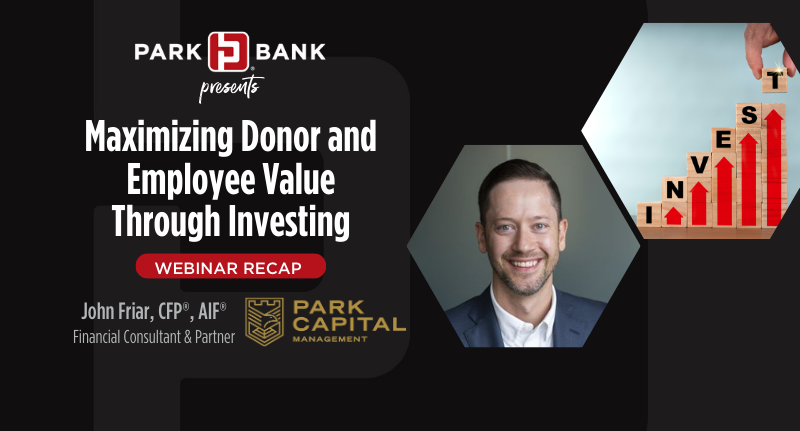Maximizing Donor and Employee Value Through Investing
Posted On: April 18, 2024 in: Nonprofit

Financial Planning and Retirement Solutions for Nonprofits and Their Employees
Introduction: The content in this article derives from John Friar’s “Maximizing Donor and Employee Value Through Investing” webinar hosted by Park Bank in March of 2024. Friar, CPF®, AIF®, is a partner and senior advisor at Park Capital Management in Madison, Wisconsin.
Want to ensure the long-term viability of your nonprofit?
It starts by making smart investments – in both your money and your employees.
This is true regardless of whether your organization has been around for 30 years or is just starting out. By following the advice in this article, you can set your organization up for success and continue making a difference in your community for years to come!
Growing An Asset Base – Financial Goals and Asset Protection
At some point, your organization is going to face a time when donor funding is lighter than normal. The key to surviving these challenging times is having an established asset base.
“I think every organization has experienced over the last three to five years where there was uncertainty and not knowing where those next dollars will come from,” John Friar, Park Capital Management Senior Advisor said. “Everyone wants to protect the value of their assets and grow. They don’t want to take a lot of risk.”
Friar recommends nonprofits consider these three investment vehicles.
- Cash Reserves: Your safe money. Cash reserves are typically shorter term, six months to a year of operating capital. (Examples: Money Market Accounts, Certificates of Deposit, Treasury Bills, Savings Accounts)
- General Investment Account: These can grow above and beyond what your safe money can. It’s going to be longer term than cash reserves, but with some flexibility. (Examples: Stocks, Bonds, Exchange Traded Funds, Mutual Funds, Investments)
- Endowment: Endowments are generally long-term and great for legacy planning. The goal is perpetuity. There are generally more restrictions with endowments.
It’s important to ask WHY your organization has either an endowment, an investment account, or a cash reserve, as these are structured differently and serve different purposes.
“We’ve heard nonprofits say, ‘We need an endowment,’” Friar said. “Well, maybe you do, maybe you don’t. Maybe that's something that’s five to 10 years away. Maybe a general investment account is the right philosophy for you right now. It’s making sure you understand what those are and what your investment policy allows for.”
The Importance of an Investment Policy Statement
Friar recommends nonprofits create an investment policy statement that establishes the guidelines for how money is used. Your policy should answer the question: “How are you deciding what investments make sense for your organization?”
An investment policy statement will help create a unified understanding – with the board, executive committee, donors, and employees – of the strategy behind how donor dollars are being used
“If you’re in a leadership position or a board member, you may not be there forever,” Friar said. “When those changes happen, you hope the organization has a policy statement in place so that the investment objectives continue and maintain.”
Friar added that your donors, board members, leadership team, and employees will be thankful you have a policy in place.
Investing in Your Employees
Speaking of your employees, they are an intricate part of your mission too!
Do they have a clear understanding of what your organization’s doing? Are you providing them with the resources for financial success?
“A lot of times we hear questions like, ‘Are your employees on track to retire? Are they feeling financially secure in their own personal finances?’” said Friar.
It can be frustrating for employees who don’t have a retirement plan when they see the organization growing and assets coming in.
“Fifty-six percent of employees think having assistance for retirement planning is a priority,” Friar said. “We want to help make sure that the people who are working hard for this community have the ability to retire when they want, where they want, and how they want.”
Friar added that today’s labor market can make it challenging to find quality employees. This makes it all the more critical that you’re doing your due diligence to take care of your staff.
“If you have good employees, you don’t want them to leave and say, “Oh, there’s another organization that has a retirement plan and some other benefits – they’re going to help me,’” said Friar.
In addition, a sense of financial security is going to make your employees more productive.
“83% of HR employees are worried that financial issues could cause productivity and employees agree,” Friar said. “I think we’ve seen that when employees are happy, they’re feeling financially secure, typically that they’re going to be more productive.”
Retirement Options
Contrary to popular belief, there are many employee retirement plan options available to nonprofits.
According to Friar, nonprofits can have a:
- Simplified Employee Pension Plan (SEP) – low complexity, low cost, “gateway” to a retirement plan
- SEP IRA – low complexity, low cost, no employee contributions - only employer contributions
- 401(k) – moderate complexity, gives maximum choice and flexibility from contributions for employee and employer
- 403(b) – moderate complexity, only available to 501c organizations (nonprofits, public schools, churches, or church employees)
- 457 plan – high complexity, flexible withdrawal rules and bonus contribution options
Be thoughtful about the plan you choose for your employees and how it will impact your organization’s long-term vision.
“If you want to grow and build your assets, don’t forget about the employees who are helping you do that,” Friar said.
